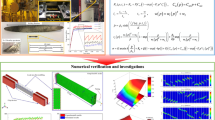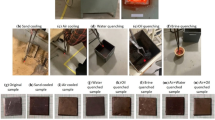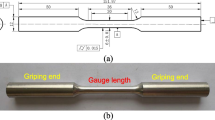Abstract
The treatment of experimental data on the amplitude-dependent internal friction (ADIF) in terms of various theoretical models has revealed a staged character and the main mechanisms of the processes of energy dissipation in graphite with increasing amplitude of vibrations upon cyclic loading. It is shown that the level of the damping capacity of lamellar cast iron depends on the relationship between the elastic and strength characteristics of graphite and the matrix phase. In cast irons with a rigid matrix structure (pearlite, martensite), the energy dissipation is determined by the volume fraction and morphology of the initial graphite phase. In cast irons with a softer metallic phase (ferrite), the contact interaction of graphite inclusions with the matrix and the properties of the matrix introduce additional sources of high damping.
Similar content being viewed by others
References
Yu. K. Favstov and Yu. N. Shul’ga, Alloys with High Damping Properties (Metallurgiya, Moscow, 1973) [in Russian].
S. A. Golovin, A. Pushkar, and D. M. Levin, Elastic and Damping Properties of Structural Metallic Materials (Metallurgiya, Moscow, 1987).
S. A. Golovin, “Dissipation of the Energy of Mechanical Vibrations in Metallic Materials with Highly Pronounced Heterogeneity,” Izv. TulGU, Ser. Materialovedenie, No. 3, 105–127 (2002).
T. E. Firle, “Torsional Damping in Pyrolytic Graphite,” Carbon 7, 595–607 (1969).
J. Merlin, M. A. Mondino, and J. Leroy, “Influence de traitements thermiques cycliques sur la précipitation dans les alliages d’aluminium contenant 25 à 30% en poids de zinc,” Phys. Status Solidi A 21, 435–442 (1974).
J. Merlin, P. Merle, F. Fouquet, and J. M. Pelletier, “Inelastic Phenomena and Structural State in Aluminum Silver Alloys,” Scr. Metall., 12, 227–232 (1978).
T. Tsuzuku, K. Kawamura, and M. H. Saito, “Precipitation of Intercalants onto Dislocations in Graphite,” Synth. Met. 6, 129–134 (1983).
M. Baba, M. Saito, and T. Tsuzuku, “Hysteretic Inelasticity of Graphite-Halogen Residue Compounds at High Temperatures,” Carbon 21, 269–274 (1983).
A. Granato and K. Lücke, “Vibrating-String Model of Dislocation Damping,” in Physical Acoustics. Principles and Methods, Vol. 4, Parts A: Applications to Quantum and Solid State Physics, Ed. by W. P. Mason (Academic, New York, 1966; Mir, Moscow, 1969).
P. Millet, R. Schaller, and W. Benoit, “Study of the Internal Friction Spectrum of Grey Cast Iron,” J. Phys. Colloque C9 44(Suppl. 12), 9–11 (1983).
S. A. Golovin and A. G. Petrushina, “Temperature Spectrum of Cast Iron Internal Friction,” Izv. Vyssh. Uchebn. Zav., Chern. Metall., No. 9, 51–54 (2009).
S. A. Golovin, “Dislocation Structure of Metals and Oscillation Damping,” in Energy Dissipation upon Oscillations of Mechanical Systems (Naukova Dumka, Kiev, 1968), pp. 329–332 [in Russian].
S. A. Golovin, I. N. Yurkin, and N. N. Nikolaeva, “Applicability of Theoretical Models in the Processing of Data on the ADIF of Iron,” in Interaction of Crystal Lattice Defects and Metal Properties (Tu’lsk. Politekh. Inst., Tula, 1979), pp. 154–160.
P. Peguin, J. Perez, and P. Gobin, “Amplitude-Dependent Part of the Internal Friction of Aluminum,” Trans. Metall. Soc. AIME 239, 438–451 (1967).
C. F. Burdett, “Internal Friction in Gadolinium,” Philos. Mag. 18, 745–752 (1968); “The Strain Amplitude Dependent Damping in Iron,” Philos. Mag. 24, 1459–1464 (1971).
W. P. Mason and D. N. Beshers, “Internal Friction during Ultrasonic Deformation of α-Brass,” J. Appl. Phys. 47(6), 2336–2344 (1976).
I. I. Renne, G. D. Petrushin, and S. A. Golovin, “Distribution of Local Deformations in Cast Iron Microregions upon Static Loading,” Probl. Prochn., No. 2, 66–68 (1981).
Author information
Authors and Affiliations
Additional information
Original Russian Text © S.A. Golovin, 2012, published in Fizika Metallov i Metallovedenie, 2012, Vol. 113, No. 7, pp. 756–760.
Rights and permissions
About this article
Cite this article
Golovin, S.A. On the damping capacity of cast irons. Phys. Metals Metallogr. 113, 716–720 (2012). https://doi.org/10.1134/S0031918X12070058
Received:
Accepted:
Published:
Issue Date:
DOI: https://doi.org/10.1134/S0031918X12070058




